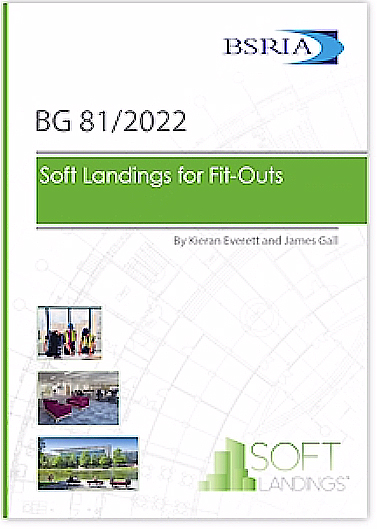Soft Landings for fit-outs
Contents |
[edit] BSRIA publishes Soft Landings for Fit-Outs (BG 81/2022)
In 2022, BSRIA announced publication of Soft Landings for Fit-Outs (BG 81/2022).
The new guide is intended for use by all parties of a fit-out project, from the client to the consultant team. It establishes the methodologies which can be adopted by the project team to promote better understanding, engagement, and contribution by all.
Soft Landings for Fit-Outs is the latest in a line of guidance publications by BSRIA on Soft Landings – the UK construction industry’s premier project improvement process. Interest in Soft Landings has been driven by increasing recognition of the vital role it now plays in the delivery of sustainable buildings; helping ensure that sustainability targets are set at the very beginning of the project, reviewed throughout, and achieved upon completion.
The new guide is available now from the BSRIA Bookshop, with free downloads available to BSRIA Members.
[edit] What is Soft Landings?
Soft Landings is a building delivery process which runs through the project, from inception to completion and beyond. It ensures all decisions made during the project are based on optimising operational performance of the building and meeting the client’s expectations.
The basis of Soft Landings is a set of principles that define a mindset for client-focused project delivery. Considered together with a supporting framework of activities arranged in six phases running from inception and briefing to post completion extended aftercare, Soft Landings runs in parallel and is complimentary to the RIBA Plan of Work.
Soft Landings can be adopted for all projects irrespective of their type and size. The level of involvement, in terms of time and effort, by the supply chain post-completion should be proportional to the nature of the project.
[edit] Soft Landings for Fit-Outs
Fit-out contracts, by their very nature, do not involve construction of new buildings. In such instances, it is therefore common for Soft Landings, as an entire process, to be overlooked. This is often due to financial or time constraints or even a misunderstanding amongst the project team that it has little relevance.
It is therefore possible that, at the point of appointing a fit-out main contractor, the benefits of adopting the Soft Landings framework have not been highlighted to the client and as such the early stages may not have been followed.
Soft Landings for Fit-Outs (BG 81/2022) addresses this by establishing methodologies which can be adopted by the project team to promote better understanding, engagement, and contribution by all.
--BSRIA
[edit] Related articles on Designing Buildings
- 2021 Soft Landings Conference.
- Better Buildings Partnership.
- BSRIA guidance on project information process BG 78/2021.
- BSRIA Soft Landings Awards.
- BSRIA updates Handover and O&M manuals.
- Building log book.
- Building owner's manual.
- Building users guide.
- Building performance evaluation.
- Building performance evaluation in non-domestic buildings guide – an introduction to the tests and methods in non-domestic buildings
- Client commissioning.
- Defects liability period.
- Extended aftercare.
- Fabric first investigation into net zero for existing buildings.
- Handover to client.
- Initial aftercare.
- Lessons learned report.
- Medical Research Council Laboratory of Molecular Biology soft landings project.
- Migration strategy.
- PAS 2038:2021 Retrofitting non-domestic buildings for improved energy efficiency.
- Post occupancy evaluation.
- Post project review.
- Performance in use.
- Performance of exemplar buildings in use: Bridging the performance gap FB 78.
- Snagging.
- Soft landings
- Soft landings - helping clients lead contractors.
- Soft landings and business-focused maintenance.
- Soft Landings and Government Soft Landings - A convergence guide for construction projects.
- Soft Landings for owners.
- Specialist commissioning manager.
- Success criteria for soft landings projects.
- Taking action on climate change.
- Technical guide.
Featured articles and news
One of the most impressive Victorian architects. Book review.
RTPI leader to become new CIOB Chief Executive Officer
Dr Victoria Hills MRTPI, FICE to take over after Caroline Gumble’s departure.
Social and affordable housing, a long term plan for delivery
The “Delivering a Decade of Renewal for Social and Affordable Housing” strategy sets out future path.
A change to adoptive architecture
Effects of global weather warming on architectural detailing, material choice and human interaction.
The proposed publicly owned and backed subsidiary of Homes England, to facilitate new homes.
How big is the problem and what can we do to mitigate the effects?
Overheating guidance and tools for building designers
A number of cool guides to help with the heat.
The UK's Modern Industrial Strategy: A 10 year plan
Previous consultation criticism, current key elements and general support with some persisting reservations.
Building Safety Regulator reforms
New roles, new staff and a new fast track service pave the way for a single construction regulator.
Architectural Technologist CPDs and Communications
CIAT CPD… and how you can do it!
Cooling centres and cool spaces
Managing extreme heat in cities by directing the public to places for heat stress relief and water sources.
Winter gardens: A brief history and warm variations
Extending the season with glass in different forms and terms.
Restoring Great Yarmouth's Winter Gardens
Transforming one of the least sustainable constructions imaginable.
Construction Skills Mission Board launch sector drive
Newly formed government and industry collaboration set strategy for recruiting an additional 100,000 construction workers a year.
New Architects Code comes into effect in September 2025
ARB Architects Code of Conduct and Practice available with ongoing consultation regarding guidance.
Welsh Skills Body (Medr) launches ambitious plan
The new skills body brings together funding and regulation of tertiary education and research for the devolved nation.
Paul Gandy FCIOB announced as next CIOB President
Former Tilbury Douglas CEO takes helm.
























